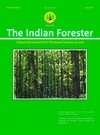Hyposidra talaca Walker (Geometridae: Lepidoptera) a New Pest (Defoliator) Recorded for Meyna spinosa Roxb. Ex Link from Assam, India
DOI:
https://doi.org/10.36808/if/2017/v143i7/119032Abstract
No Abstract.References
Basu Majumdar A. and Ghosh P. (2004). Hyposidra talaca(Walker) a destructive pest of tea in Dooars tea plantations. Two and a Bud, 51:49-51.
Browne F.G. (1968). Pests and diseases of forest plantation trees: an annotated list of the principal species occurring in the British Commonwealth. Clarendon press, Oxford.
Chutia B.C., Rahman A., Sarmah M., Barthakur B.K. and Borthakur M. (2012). Hyposidra talaca (Walker): A major defoliating pest of tea in North East India. Two and a Bud, 59:17-20,
Das S. and Mukhopadhyay A. (2008). Host based variation in life cycle traits and general esterase level of the tea looper Hyposidra talaca (Walker) (Lepidoptera: Geometridae). J. Plantation Crops, 36(3):457 - 459.
Das S. and Mukhopadhyay A. (2009). An insight into the looper complex of tea from Darjeeling Terai. In: Proceedings of the National symposium on IPM strategies to combat emerging pests in the current scenario of climate change, Entomological Society of India, IARI, New Delhi, pp. 45.
Das S., Mukhopadhyay A. and Roy S. (2010). Morphological diversity, developmental traits and seasonal occurrence of looper pests (Lepidoptera : Geometridae) of tea crop. J. Biopesticides, 3(1):016 - 019
Dharmadi A. (1983). Evaluation on the important tea pest control by Fenthion insecticide on several spraying intervals. Depertemen Biologi ITB. Dibuat; 1983-10-07, dengen 1 file(s).
https://www.mothsofborneo.com (Accessed on 05 May, 2016).
Mathew G., Shamsudeen R.S.M. and Chandran R. (2005). Insect fauna of Peechi-vazhani wild life sanctuary, Kerala, India. Zoos' Print Journal, 20(8):1955- 1960.
Meena S.C., Sharma K.K., Mohanasundaram A., Verma S. and Md. Monobrullah (2014). Insect-Pest Complex of Flemingia semialata Roxb - a bushy host for lac cultivation. The Bioscan, 9(4):1375-1381.
Parikh P., Sonavane S. and Ahir K. (2010). Diversity of moths in GIR protected area, Gujarat. Deccan Current Science, 3(2):122-129.
Sharat Singh N.K., Radhapiyari W., Choudhury Md. A.H., Brojendro Singh Th., Bonny Kh., Sobita Devi Th., Rajeshwari Devi R.K. and Rajmuhon Singh N. (2015). Spectrospcopic study of antioxidant property and trace elements of Meyna spinosa Roxb. ex Link leaves. Indian J. Natural Products and Resource, 6(1):51-55.
Tea Research Association. (2011). Tea Looper Caterpillar, Bulletin No. PP/02/2011.
Winotai A., Wright T. and Goolsly J.A. (2005). Herbivores in Thailand on Rhodomyrtus tomentosa (Myrtacae), an invasive weed in Florida. Florida Entomologist, 88(1):104-105.
Downloads
Downloads
Published
How to Cite
Issue
Section
License
Unless otherwise stated, copyright or similar rights in all materials presented on the site, including graphical images, are owned by Indian Forester.





